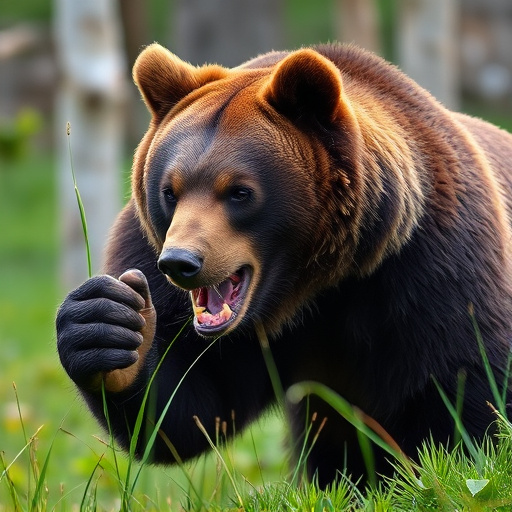Grizzly bears pose significant risks in wild environments due to their powerful build, protective nature, keen sense of smell, and ability to detect threats. Pepper spray, containing capsaicin, can deter charges temporarily (15-30 seconds), but its effectiveness is context-dependent, with factors like wind direction impacting reach and duration. For proper use, aim for the bear's face, eyes, and nose at a distance of 20-30 feet, and follow immediate application techniques. In areas where pepper spray may be ineffective, outdoor adventurers should rely on alternative methods like recognizing bear behavior, appearing larger, making loud noises, and carrying defensive objects to deter charges and provide escape time.
In the vast wilderness, encounters with grizzly bears can be terrifying. Understanding bear behavior and equipping yourself with effective defense mechanisms is crucial for safety. This article explores how to navigate these powerful predators, focusing on pepper spray as a primary tool. We delve into the science behind its use, including application techniques and the duration of its contamination (how long it remains effective). Additionally, we present alternative defenses for those seeking more comprehensive wilderness survival strategies beyond pepper spray.
- Understanding Grizzly Bear Behavior and Their Response to Pepper Spray
- Effective Use of Pepper Spray: Application Techniques and Timing
- Alternative Defense Mechanisms in the Wild: Beyond Pepper Spray
Understanding Grizzly Bear Behavior and Their Response to Pepper Spray
Grizzly bears are powerful animals with an innate sense of territory and a strong protective instinct for their cubs and food sources. Understanding their behavior is crucial when it comes to self-defense in wild environments. These bears have an excellent sense of smell, which they use to detect potential threats or prey from great distances. When confronted with a perceived danger, grizzlies may charge as a defensive mechanism.
Pepper spray has been long considered a non-lethal deterrent against bears and other wildlife. Its primary active ingredient, capsaicin, causes temporary disorientation and pain when inhaled by the bear. However, it’s important to note that pepper spray’s effectiveness depends on factors like wind direction and proximity to the bear. The spray can contaminate the air for a certain period, typically ranging from 15 minutes to an hour, making it challenging to determine how long it remains potent enough to deter a charge. While it can be a valuable tool, it should be used as a last resort when all other escape or de-escalation strategies have failed.
Effective Use of Pepper Spray: Application Techniques and Timing
When facing a charging grizzly bear, one effective defense mechanism is pepper spray. It’s crucial to understand how to use it properly. The key lies in application techniques and timing. Aim for the bear’s face, eyes, and nose—these areas are highly sensitive, temporarily blinding and disorienting the animal. Spray from a distance of 20-30 feet (6-9 meters) to avoid inhalation by yourself.
In terms of how long pepper spray contaminates, it varies depending on factors like concentration and weather conditions. Typically, the effects last between 15 to 30 seconds. However, in harsh conditions or with higher concentrations, this duration can extend. Remember, timing is critical—act swiftly when spraying, as a delayed response might allow the bear to close the distance and attack.
Alternative Defense Mechanisms in the Wild: Beyond Pepper Spray
In situations where pepper spray is not readily available or its effectiveness is questionable, wilderness enthusiasts and outdoor adventurers must rely on alternative defense mechanisms to deter charging grizzly bears. Beyond pepper spray, knowledge of bear behavior and specific tactics can significantly increase survival chances. Understanding when a bear might charge and recognizing the distinct sounds and movements that signal an attack are crucial first steps.
One effective strategy is to make oneself appear larger by raising arms or wearing reflective clothing, which can confuse a charging bear’s sense of smell and sight. Creating loud noises with whistles, bells, or even singing atop a rock can often deter bears due to their sensitivity to sudden sounds. Additionally, carrying objects that can be used as weapons in a pinch, like trekking poles or a sturdy hiking staff, might provide a means of defense if needed. It’s important to note that these alternatives are not foolproof but can offer valuable time and space for an individual to retreat safely from a potential bear encounter.
When facing a charging grizzly bear, understanding their behavior and employing effective defense mechanisms can be life-saving. While pepper spray is a popular choice for its immediate impact, it’s crucial to know its duration of effectiveness—typically lasting only a few seconds—and that proper application techniques are key. Exploring alternative defenses beyond pepper spray, such as loud noises or bear spray, offers additional layers of protection when navigating wilderness areas known for grizzly bear presence. Remember, preparation and knowledge are paramount in mitigating risks during encounters with these majestic yet potentially dangerous creatures.
